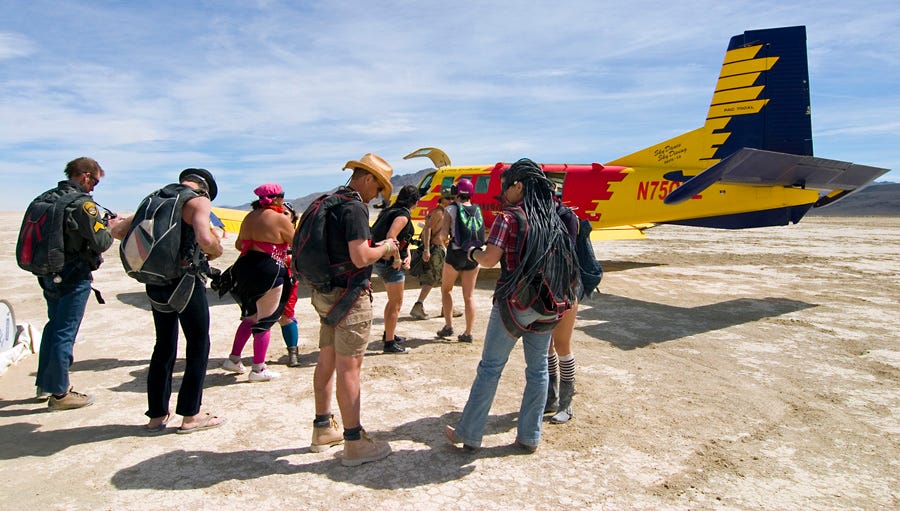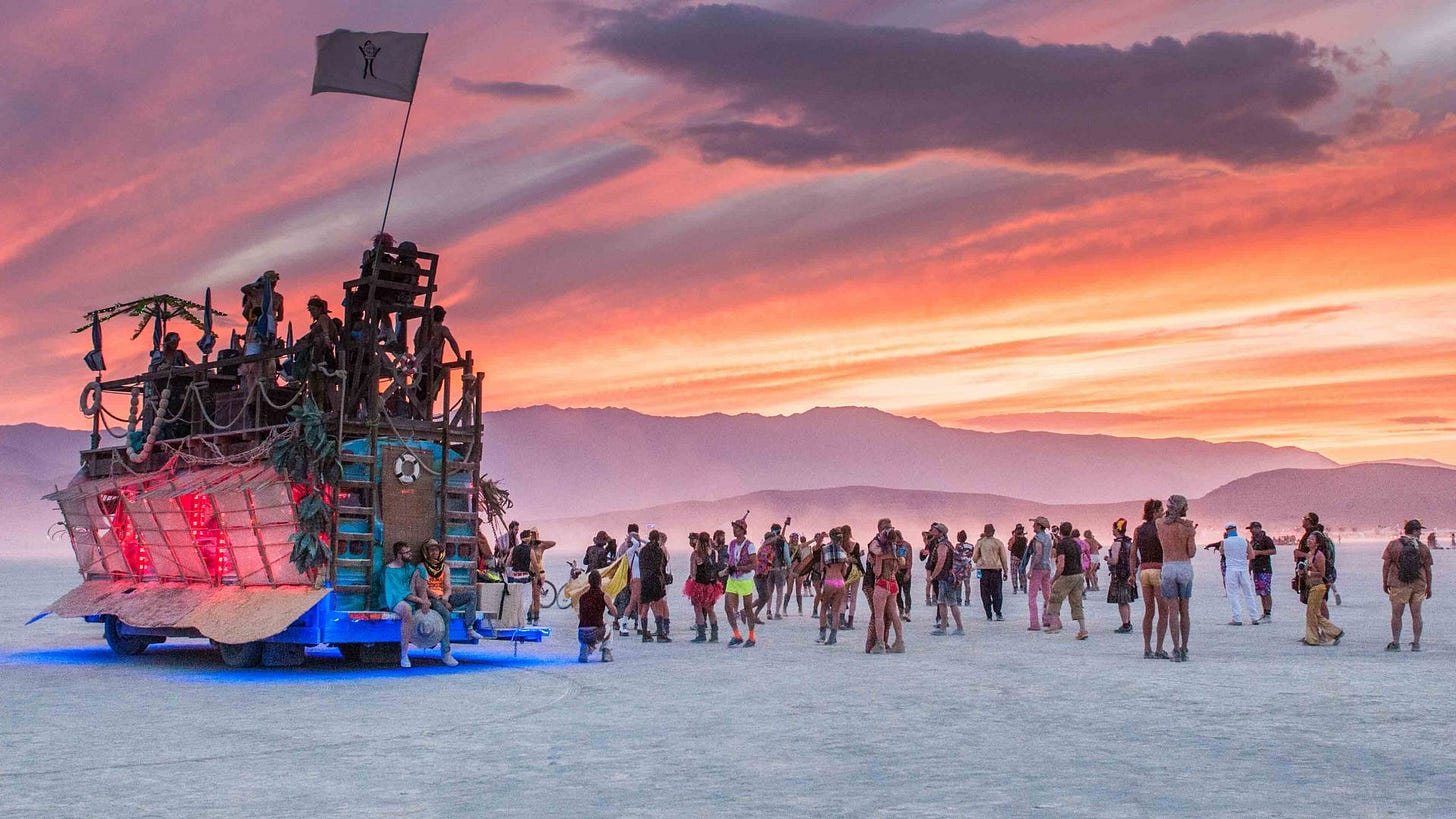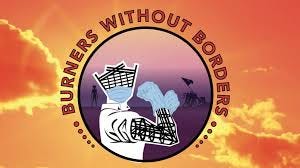Burning Man Now and Then
Burning Man and Making Plans
Quick heads up for interested folks: We’re hosting a new digital course, AntiFragile You, all about combining neuroscience, peak performance, dynamic leadership and collapse-awareness, all in one rollicking, empowering good fun training.
If you’re curious about the healthy Venn overlap between personal optimization and late stage everything, check it out here—starts in a couple weeks!
***
In honor of this week’s desert festivity and the twentieth anniversary of Hurricane Katrina, thought I’d share this excerpt from Stealing Fire about the potential for innovation and real world disaster support inspired by Burning Man.
Some of the characters mentioned have taken on different optics in that time (like Tony Hseih and Elon Musk). I’ve left them in, both to see how much remains true, and how much has shifted in our current upside down moment.
Hope you enjoy it!
from Stealing Fire
Every year, some three hours northeast of Reno, on a vast alkali flat known as the Black Rock Desert, a culture and arts festival called Burning Man kicks off.
(as you read this, it’s heading into its climactic weekend).
There are lectures on neurotheology by Ivy League scientists, workshops by world-renowned sex therapists, performances by world famous musicians, and every head-bending alphabetamine madcap chemist Sasha Shulgin ever dreamed up.
Off in the distance, you might even spot the Red Bull Air Force, dressed up in flaming costumes and skydiving into the city.
Whatever else can be said about the event, Burning Man holds the undisputed title as the largest transformational engine ever invented.
80,000 tribal primates, whose consciousness has been mutated by ingesting cannabinoids, phenethylamines and tryptamines all gathered together in a circular desert encampment shaped like a Mayan calendar.
A giant anthropomorphic effigy at the dead center, that shoots out to an interfaith Temple at the focal point beyond it all.
Pan back even further and you realize the entire thing is bounded by a giant orange pentagon “trash fence,” defining the boundaries of this otherwise liminal space.
Then, we charge that fucker all the way up to Transmorgify, populate it with art cars, avatars and otherworldly architecture, music, dance and pranks (all directly inspired by said chemically induced brain mutations), and the entire encampment becomes its very own human powered sigil––a magical object of geometry and intention that thrums and pulses with a unique combination of serendipity and metabolic alchemy.
We did this, in other words, to (and for and by) ourselves.
Sometimes evolution proceeds through the uninspired brute-force algorithm of survival of the fittest, and at other times, it leaps and mutates into an entirely new something, seemingly from nothing.
Parthenogenesis. AKA the Virgin Birth. Ex Nihilo (something, out of no-thing).
And if inspired Play, (or Lila in the vedic traditions) is the pinnacle of novelty seeking in the Universe, you gotta give Burning Man top marks for frothing all that quantum foam.
“Burning Man aggressively extends the tradition of hedonic ecstasy” writes Erik Davis. “[Wild] visuals, disorienting sonics, and a self-conscious excess of sensory stimulation . . . all help undermine stabilized frames. . . . [It’s a] full-sensorium brain machine designed to bring us in tune with our mind’s ongoing construction of real-time on the fly.”
Michael Michaels, one of Burning Man’s original founders (and known as “Danger Ranger” at the event), explains it this way:
“At Burning Man, we’ve found a way to break out of the box that confines us. What we do, literally, is take people’s reality and break it apart. Burning Man is a transformation engine—it has hardware and it has software, you can adjust it and tweak it. And we’ve done that.
We take people out to this vast dry place, nowhere, very harsh conditions. It strips away their luggage, the things they’ve brought with them, of who they thought they were.
And it puts them in a community setting where they have to connect with each other, in a place where anything is possible. In doing so, it breaks their old reality and helps them realize they can create their own.”
In other words, it’s a transformation engine tailor-made to invoke the selflessness, timelessness, effortlessness, and richness of the ecstatic state.
Increasingly, that transformation engine has been producing real change in the world.
Because past all the hype and huff, the next obvious question is: does all this radical inspiration lead to practical innovation?
Lab studies have been demonstrating that nonordinary states can meaningfully boost creativity and problem solving under controlled conditions.
But what if we want to step outside the lab and see if ecstasis is helping solve wicked problems “in the wild.”
Burning Man is perhaps the best place to begin this inquiry.
The first thing to note is who’s showing up at the festival. Unlike in the Woodstock era, attendees are no longer just countercultural bohemians who have “tuned in, turned on, and dropped out.”
For sure, there are still plenty of punk anarchists, industrial artists, and warehouse denizens for whom life in the mainstream is a sometimes awkward fit.
But today, the ranks of Burners, as attendees call themselves, include members of a high- powered subculture, a tech-nomadic glitterati that have access to capital, markets, and global communication platforms.
When Tim Ferriss mentioned that nearly all of the billionaires he knows in Silicon Valley take psychedelics to help themselves solve complex problems, Burning Man is one of their preferred locations to step out and go big.
Among certain circles, mention of “the playa” or “Black Rock City” gains you instant camaraderie with those who have shared that baptism by fire. Participation in successful Burning Man camps has morphed from countercultural street cred to career-building material.
“So embedded, so accepted has Burning Man become in parts of tech culture,” wrote journalist Vanessa Hua in the San Francisco Chronicle, “that the event alters work rhythms, shows up on resumes, is even a sanctioned form of professional development— all signs that the norm has adopted parts of the formerly deviant happening.”
Over the last decade in particular, the festival has become a regular stop for those whose calendar might include Davos, TED, and a slew of other high-profile gatherings.
A decade ago , John Perry Barlow, a fellow at Harvard Law School and former lyricist for the Grateful Dead, casually tweeted from Burning Man:
“Spent much of the afternoon in conversation with Larry Harvey, Mayor of Burning Man and Gen. Wesley Clark, who is here.”
At one of the more infamous parties on the planet, countercultural royalty are hobnobbing with a former Supreme Commander of NATO turned U.S. presidential candidate.
Perhaps there’s more going on than just a weeklong party.
And that’s the second thing to explore in our assessment— why so many creative and talented people go so far out of their way to congregate there once a year.
By simple elimination, it can’t just be the sex, drugs, or music. Those indulgences, however tantalizing, are little more than commodities in any major city.
There must be a pretty compelling something that inspires people to take a week out of their calendars to wander around an inhospitable salt flat in the middle of absolute nowhere.
Recent research conducted on Burning Man sheds some light on that “something.”
A team of scientists led by Oxford neuropsychologist Molly Crockett joined forces with the Black Rock City Census to take a closer look at the festival’s power.
In their study, 75 percent of attendees reported having a transformative experience at the event, while 85 percent of those reported that the benefits persisted for weeks and months afterward.
That’s an incredibly high batting average: Three out of four people who attend the event are meaningfully changed by it.
And this doesn’t just happen by accident. Wandering out into the middle of that intentional chaos at 2 A.M., surrounded by fire-spewing dinosaurs, giant neon- lit pirate ships, and the throbbing beats of galactic hip-hop, you’re ripped away from all familiar reference points, totally unstuck in time, and well beyond normal awareness.
The wildness of the event, the radical self-reliance it requires, the ability to create and inhabit larger-than-life alter egos, all combine to create a temporary autonomous zone—a place where people can step outside themselves and create, if only for a brief week, whatever they desire.
It’s the single greatest concentration of state-altering technology on the planet, designed by everyone together and no one in particular.
***
Which brings us to the final and most important category in our assessment: the astonishing amount of innovation this event consistently inspires.
Attendees treat the playa as an oversized sandbox—a place where ideas can be dreamed up, tested out, and, as often as not, shared freely with everyone. “I like going to Burning Man,” Google founder Larry Page said at the Google I/O conference.
“[It’s] an environment where people can try new things. I think as technologists we should have some safe places where we can try out things and figure out the effect on society, the effect on people, without having to deploy it to the whole world.”
In 2007, Elon Musk did just that, debuting an early prototype of his Tesla electric roadster at the event. He also came up with the ideas for both his renewable energy company SolarCity and his superfast transit system Hyperloop while on the playa.
And true to the Burning Man principle of gifting, he gave both away. SolarCity went to his cousins; Hyperloop, published online in a white paper, was an offering to the world at large (that has since inspired two different companies).
Zappos founder and CEO Tony Hsieh told Playboy that the experience of collective awareness, what he calls “the hive switch,” is the reason he attends. That “feeling of unity with the other people in the space, unity with the music and with one another . . . that’s why I go to Burning Man.”
For Hsieh, the festival has had such an impact that he’s built its ideas into the corporate culture of Zappos, reorganizing the company to make flipping “the hive switch” as easy as possible.
Similarly, he’s also spearheaded the Downtown Project, an attempt to revitalize central Las Vegas with radical inclusion, interactive art, and other core festival elements.
While much has been made of the fact that Hsieh’s efforts have faced setbacks and challenges, it would be surprising if things went differently. Hsieh has taken ideas pioneered at Burning Man and is attempting to deploy them to reinvent the culture of a Fortune 500 company and to reinvigorate (to the tune of $350 million) a blighted urban core.
That’s structural change in the real world, with all the risks and complications it entails.
Musk’s projects too, aren’t without their complications.
But reinventing transportation and pioneering a new energy grid (to say nothing of his efforts to colonize Mars) are wicked enough problems that they’ve stymied all prior efforts to solve them.
What these examples make clear is that the perspective provided by nonordinary consciousness and culture offers a different path forward—a way to reconsider intractable challenges with fresh eyes.
All of these practical applications have, in turn, inspired the Burning Man organization itself. A few years ago, we attended the event to speak at their annual TEDx series and then got invited to a small salon hosted by Danger Ranger. Interestingly, it wasn’t just Silicon Valley tech titans in attendance. Senior vice presidents from Goldman Sachs, heads of the largest creative ad agencies in the world, and leaders of the World Economic Forum, were all discreetly there, using fanciful assumed names, far from the flashbulbs and scrutiny of the media and the markets. Their goal was to forge a future based on the shared experience of communitas writ large: a permanent Burning Man community, a place where experiments with the four forces could be conducted year round.
As Burning Man cofounder Will Roger recently wrote “I would argue that the proposal is part of a large strain of utopian separatism that can be found in the modern- tech boom: Peter Thiel’s Seasteading efforts or Tony Hsieh’s attempt to build a start-up city in Las Vegas.
***
When the Levee Breaks
One of the more interesting parts of this story is that some of the hardest and grittiest lessons of building a city from scratch are showing up thousands of miles beyond the Nevada desert.
So, if we want to continue our exploration of how nonordinary states are helping to solve wicked problems “in the wild,” then we should head to some of the wildest places on earth—those ravaged by natural disasters and protracted war.
To better understand how a weeklong gathering could have such far-reaching impact, it’s important to understand that in preparation for the event, all the central Burning Man organization does is survey the streets and put out port-a-potties.
Everything else about the makeshift city—the camps, the giant art, the generators, the medical facilities, and the peacekeeping—is organized by volunteers. In coming together to create a city of seventy thousand, Burners are pioneering fundamentally different ways of organizing and mobilizing people in the face of some of the harshest conditions on the planet—and they’re using the bonding power of communitas to do it.
One of the first times those skills got truly put to the test was in 2005. It was August 29, and over on the Gulf Coast Hurricane Katrina was less than an hour from making landfall.
By the time the storm was over, it would spread $108 billion of damage from Florida to Texas, and earn the dark honor of being one of the five worst hurricanes in U.S. history.
Over in Nevada, meanwhile, it was sunny skies and light winds and Burning Man was in full swing. Camp PlayaGon (a combination of playa and Pentagon) was bustling.
A collection of high-ranking Pentagon officials, futurists, and hackers, PlayaGon had been charged with setting up and running the livestream broadcast and emergency Wi-Fi for the entire festival. But when news of Katrina reached them, they took a break from their duties to get a closer look.
“One of our guys took over a recon satellite” recounts Dr. Bruce Damer, a University of California biomedical engineer and NASA contractor. “Our Pentagon wireless satellite phone rang, the general on the other side was saying ‘what’s going on’ and instructing our guy not to answer. We then had control of this thing and could watch Katrina come in.”
And never ones to miss an opportunity for a high-tech prank, the PlayaGon crew lit dozens of hydrazine flares (military-spec glow-sticks) around their camp and programmed the satellite to track that blaze from space, too.
But those real-time feeds of Katrina lashing the Gulf Coast had a sobering impact. The citizens of PlayaGon wanted to help. So did plenty of other Burners. After gathering more than forty-two thousand dollars in relief money from concerned attendees, an advance team left the festival, drove down to the Gulf Coast, and got to work.
With Doctors without Borders as their inspiration, they dubbed their nascent organization Burners without Borders. At the time, New Orleans was getting all the national attention, but these Burners decided to focus their efforts on coastal towns in Mississippi, which had been equally damaged but largely ignored.
The first thing they did was set up shop in a parking lot and build a much-needed distribution center for established charities like Oxfam and the Red Cross. Then, over the course of eight months, they donated more than $1 million in debris removal and reconstruction efforts.
The organization did everything from restore a Vietnamese temple in Biloxi to raze and rebuild the entire town of Pearlington. As CNET noted: “This was no ragtag group of 10 to 20 hopeless do-gooders showing up without a plan.
This was more than 150 people, toting heavy equipment, supplies of food and water, [and] years of experience surviving and thriving in harsh, off-the-grid environments.”
Before leaving, they teamed up with local residents to build a giant sculpture out of flood debris and, true to form, turned it to ash in a giant, cathartic bonfire. “Our town was destroyed and we were abandoned by our government and our leadership,” one Pearlington resident said, “but [Burners without Borders] came in and reminded us that even in all that devastation was the chance for art, for celebration and for community.”
Since that time, Burners without Borders has become an international organization, active in disaster zones from Peru’s 2007 earthquake to Japan’s Fukushima disaster to New Jersey’s Hurricane Sandy. And the relationships they’ve forged with locals in those areas have come full circle—with leaders from those communities coming to Burning Man in subsequent years to learn where all of that capability and enthusiasm comes from.
While Burners without Borders mark one of the earliest examples of festival principles being exported into crisis zones, they’re unlikely to be the last.
“With so much experience in self-organizing their own municipal infrastructure in a hostile environment,” former Apple executive Peter Hirshberg wrote in his book From Bitcoin to Burning Man and Beyond, “Burners are particularly skilled at functioning during chaotic crises when normal services—running water, electricity, communication channels and sanitation systems—are not available. Burners don’t just survive in such an environment; they create culture, art and community there.”
It’s for this reason that Rosie von Lila, a former head of community affairs for the Burning Man organization, has been invited to the Pentagon three times and the United Nations twice to discuss infrastructure and disaster planning.
“I’ve been amazed at the depth of interest,” Von Lila says. “[T]raditional organizations are realizing the limitations of top-down mobilization and are seriously studying how bottoms-up community mobilization—the core lessons of the Burning Man community—can be deployed in critical environments.”
Or, really, in any kind of environment. Burning Man “demonstration projects” can be seen everywhere from solar power installations on rural Indian reservations (Black Rock Solar) to experimental community spaces in blighted metropolitan areas (The Generator, in Reno, Nevada) to smartphone apps (including Firechat, which was designed as a peer-to-peer communication network at Burning Man, but then played a critical role in protest movements in Taiwan, Hong Kong, and Russia).
And because Burners vigorously defend an open-source, noncommercial approach, their efforts are easy to share and hard to censor.
Burning Man “regional burns” now occur in nearly thirty countries, from Israel to South Africa to Japan, providing global access to the experience.
It’s been called a countercultural diaspora, but that might be too limiting.
After all, what’s countercultural about disaster relief, intelligence-gathering, and urban planning?
These projects all provided creative solutions to persistently wicked problems, ones that defied the best laid plans of the most powerful militaries, governments and aid agencies on the planet. Relying on the ingenuity, collaboration, and relentless hard work of a community forged by ecstasis, Burners are extending their impact well beyond the celebration that birthed them.
“Burning Man didn’t invent the festival, the art car, or the Temporary Autonomous Zone any more than Apple invented the personal computer,” continues Hirshberg. “But like that other venturesome innovator . . . Burning Man executed the concept beautifully, and through its work is having an outsized impact on our culture—and quite possibly on our future.”
***
While Burning Man principles and skills are being deployed in some of the harshest conditions on earth by volunteers with limited budgets, a large number of these examples have involved the creative class—that is, people with the resources, influence, and time needed for such pursuits. And, typically, that’s the way these things have always worked.
At least as far back as the Eleusinian Mysteries, which counted notables such as Plato and Pythagoras among its members, ecstatic culture has often been spread by an educated elite.
In Europe, we saw this with the Rabelaisians of the sixteenth century, and the Club de Hashish in the eighteenth century—both of whom explored altered states, open sexuality, and libertine philosophies in pursuit of inspiration.
In the 1920s socialite Mabel Dodge Luhan’s Taos home served as a mescaline-fueled salon for everyone from D. H. Lawrence to Georgia O’Keeffe and Carl Jung.
In the 1960s Esalen’s founders and faculty infused bohemia with academia, drawing heavily from the ranks of Stanford, Harvard, and the European intellectual community.
Yet, even though these movements all began with a select few, they ended up having a disproportionate impact on philosophy, art, and society.
Whether our current movement will end up sharing some of that “trickle down ecstasis” with the masses, or devolve into the Capital of Panem remains to be seen…









It was better next year.
love it and actually staying home this year after 17 burns to put my creative energy into form in the real world... and it's really something to have musk and especially theil referenced in the positive given where we are now...